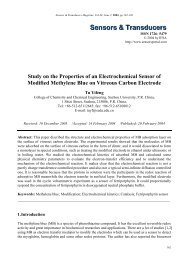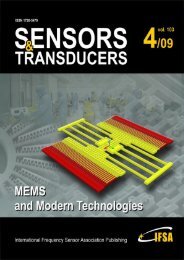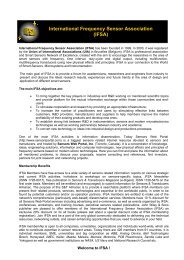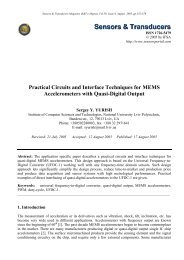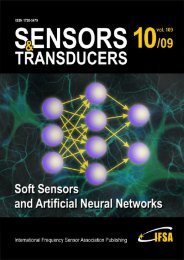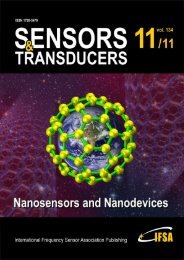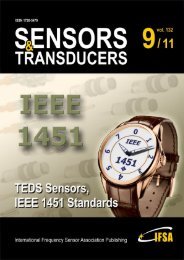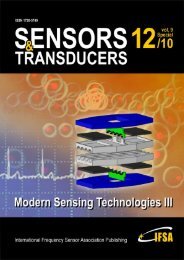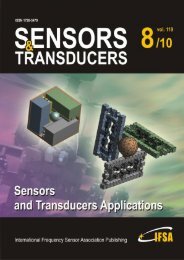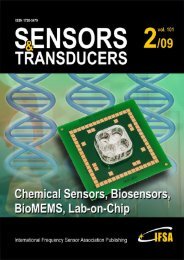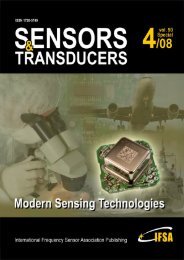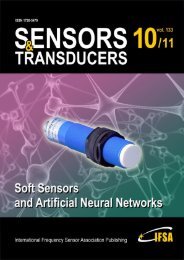Bio-Techniques in Electrochemical Transducers: an Overview
Bio-Techniques in Electrochemical Transducers: an Overview
Bio-Techniques in Electrochemical Transducers: an Overview
Create successful ePaper yourself
Turn your PDF publications into a flip-book with our unique Google optimized e-Paper software.
Sensors & <strong>Tr<strong>an</strong>sducers</strong> Journal, Vol.82, Issue 8, August 2007, pp. 1405-1417<br />
Ferrocene (h2-bis-cyclopentadienyliron) <strong>an</strong>d its derivatives [47], cofactors based on nicot<strong>in</strong>amide<br />
aden<strong>in</strong>e d<strong>in</strong>ucleotide(NADH_ <strong>an</strong>d NADP_ [48], catalysts [49], <strong>an</strong>tibodies <strong>an</strong>d <strong>an</strong>tigens [50]. Studies<br />
on the use of biosensors for gene detection are relatively recent <strong>an</strong>d still uncommon.<br />
Deoxyribonucleicacid (DNA) has recently been suggested as a biological recognition element for such<br />
biosensors [51-52]. The unique nucleotide base structure of DNA provides the basis of the technique<br />
which allows s<strong>in</strong>gle str<strong>an</strong>ded DNA (ssDNA) to be used to identify other ssDNA molecules with the<br />
complementary bases [53]. Therefore, nucleic acid hybridisation is the underly<strong>in</strong>g operat<strong>in</strong>g pr<strong>in</strong>ciple<br />
of DNA biosensors. Dur<strong>in</strong>g the last decade, there have been m<strong>an</strong>y adv<strong>an</strong>ces <strong>in</strong> DNA biosensor<br />
technology <strong>an</strong>d most work has focused on electrochemical, piezoelectric <strong>an</strong>d optical tr<strong>an</strong>sducers.<br />
Attempts to develop <strong>an</strong> electrochemical DNA biosensor have been made by several groups [54-55]. In<br />
these sensors, <strong>an</strong> ssDNA str<strong>an</strong>d is covalently bound to the surface of <strong>an</strong> electrode. Hybridization of the<br />
immobilized sequence with its dissolved complement forms the double str<strong>an</strong>d that c<strong>an</strong> be detected<br />
us<strong>in</strong>g a DNA-specific redox-active metal: polypyrid<strong>in</strong>e complex. Damaged segments of DNA c<strong>an</strong> also<br />
be detected by measur<strong>in</strong>g ch<strong>an</strong>ges <strong>in</strong> the redox signals of base residues <strong>in</strong> DNA immobilized on carbon<br />
electrodes. Covalently closed circular DNA c<strong>an</strong> be attached to <strong>an</strong> electrode surface to obta<strong>in</strong> a sensor<br />
that detects a s<strong>in</strong>gle break <strong>in</strong> the DNA sugar-phosphate backbone, or for the detection of agents<br />
leav<strong>in</strong>g the DNA backbone such as hydroxyl radicals, ioniz<strong>in</strong>g radiation or nucleases [56].DNA<br />
sens<strong>in</strong>g protocols, based on different modes of nucleic acid <strong>in</strong>teraction have been reviewed [57] by<br />
W<strong>an</strong>g et al. (1997). The review describes recent efforts to couple nucleic acid recognition layers to<br />
electrochemical tr<strong>an</strong>sducers. Peptide nucleic acids (PNAs) have been found to exhibit unique <strong>an</strong>d<br />
efficient hybridization properties that may offer signific<strong>an</strong>t adv<strong>an</strong>tages for sequence-specific<br />
recognition compared to their DNA counterparts. The adv<strong>an</strong>tages <strong>in</strong>clude higher sensitivity <strong>an</strong>d<br />
specificity, faster hybridization at room temperature <strong>an</strong>d m<strong>in</strong>imal dependence upon ionic strength. The<br />
use of PNA <strong>in</strong>corporated with a Co (phen) (3) (3+) redox <strong>in</strong>dicator on a carbon electrode for the<br />
detection of sequence specific DNA has been discussed [58].<br />
3. Design<strong>in</strong>g of <strong>Bio</strong>sensors<br />
Design <strong>an</strong>d construction technology <strong>an</strong>d material science are <strong>in</strong>timately l<strong>in</strong>ked <strong>in</strong> biosensor<br />
development. Therefore, discussions of biosensor design <strong>an</strong>d fabrication should always <strong>in</strong>volve the<br />
selection of materials. An electrochemical biosensor usually consists of a tr<strong>an</strong>sducer such as a pair of<br />
electrodes or FET, <strong>an</strong> <strong>in</strong>terface layer <strong>in</strong>corporat<strong>in</strong>g the biological recognition molecules <strong>an</strong>d a<br />
protective coat<strong>in</strong>g. Sensor design, <strong>in</strong>clud<strong>in</strong>g materials, size <strong>an</strong>d shape <strong>an</strong>d methods of construction, are<br />
largely dependent upon the pr<strong>in</strong>ciple of operation of the tr<strong>an</strong>sducer, the parameters to be detected <strong>an</strong>d<br />
the work<strong>in</strong>g environment. Traditional electrode systems for measurements of the concentrations of<br />
ions <strong>in</strong> liquids <strong>an</strong>d dissolved gas partial pressures conta<strong>in</strong> only a work<strong>in</strong>g electrode (usually a noble<br />
metal wire) <strong>an</strong>d <strong>an</strong> electrically stable reference electrode, such as Ag: AgCl, though a counter<br />
electrode is sometimes <strong>in</strong>cluded. A simple electrical, or chemical, modification may sometimes<br />
improve specific electrode properties. For example, repeated potential cycl<strong>in</strong>g of 0.3 mm diameter<br />
carbon rods <strong>in</strong> 0.1 M potassium hexacy<strong>an</strong> ferrate improved the stability of glucose sensors for up to<br />
6.5 days [59]. However, with the exp<strong>an</strong>d<strong>in</strong>g dem<strong>an</strong>ds for more complex measurements, the rapid<br />
development of materials science <strong>an</strong>d the emergence of micro- <strong>an</strong>d n<strong>an</strong>oprocess technology, <strong>in</strong>direct<br />
electrochemical methods <strong>in</strong> simple biosensors to monitor enzyme activity have gradually been<br />
replaced by more direct, but more complex processes. Methods for the preparation of electrochemical<br />
electrodes are well established. Some of these techniques are used to prepare the conductive<br />
support<strong>in</strong>g substrate, while others are employed to achieve <strong>an</strong> efficient electrical communication<br />
between the chemical reaction site <strong>an</strong>d the electrode surface, high levels of <strong>in</strong>tegration, sensor<br />
m<strong>in</strong>iaturization, measurement stability, selectivity, accuracy <strong>an</strong>d precision. In addition, the technique<br />
used to immobilize the biological recognition components of the sensor c<strong>an</strong> affect biosensor<br />
perform<strong>an</strong>ce signific<strong>an</strong>tly.<br />
1410



